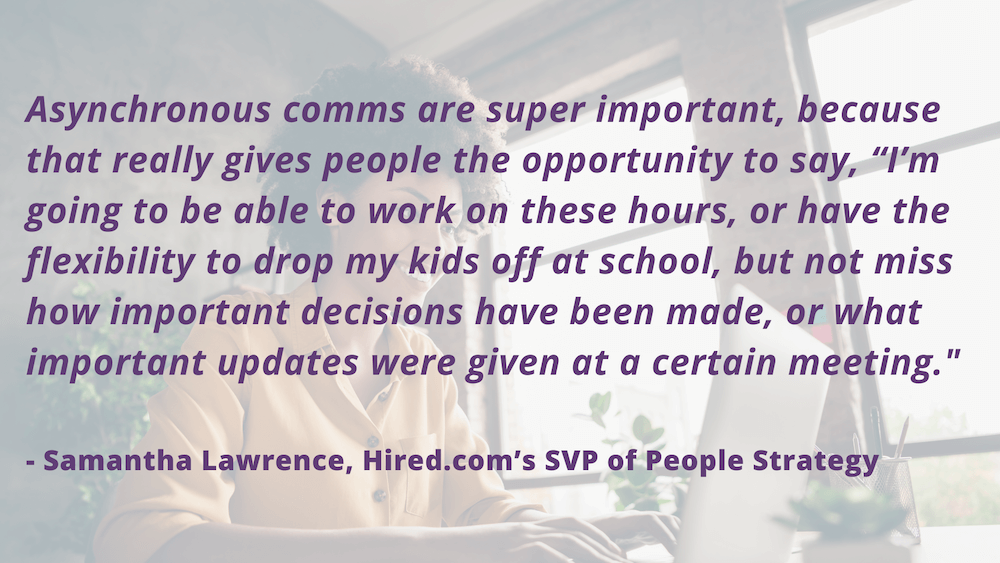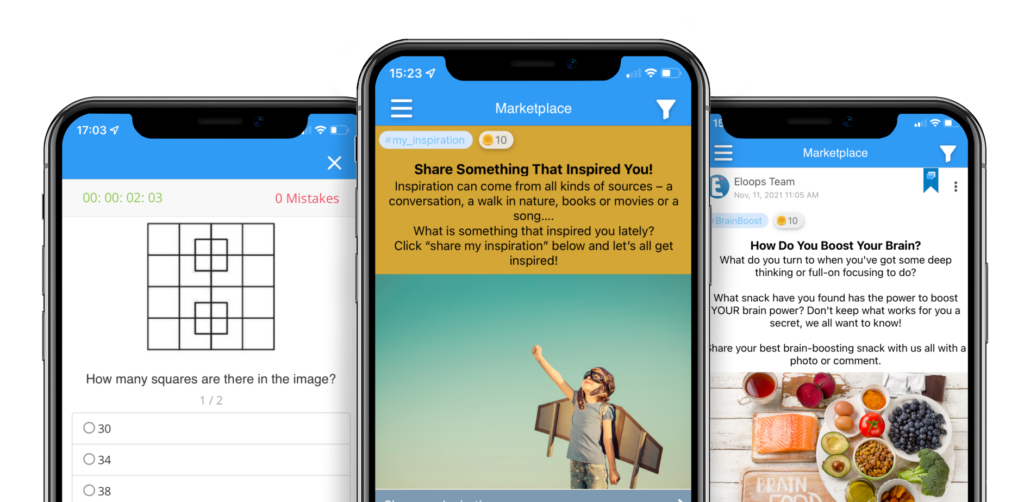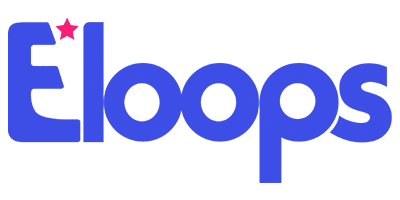Flexibility, Connection, And Asynchronous Employee Communication
How to Meet the Evolving Needs of Today’s Hybrid Workforce
What has been causing employees to quit their jobs in droves? Surveys reveal two fundamental drivers: the need to work remotely and flexibly and the need to have a greater sense of belonging and community at work. These seem inconsistent – after all, working in different places or at different times from colleagues tends to engender isolation and make employees feel disconnected from each other and the organization. However, it is possible to meet these needs simultaneously using an advanced asynchronous communication solution. Employers trying to retain their talent by allowing WFH and schedule flexibility would be well advised to adopt such a solution to address the ‘human’ aspects of work in a remote/hybrid environment.
Flexibility and the Great Resignation
More than 4 million people voluntarily quit their jobs each month between May 2021 and May 2022. While various factors play a part in the continuation of what has been dubbed ‘the Great Resignation,’ surveys conducted by both McKinsey and Future Forum point to a significant contributor: people are upset about the possibility of losing the increased WFH and schedule flexibility they gained during the pandemic. While working from home, employees got used to a higher level of autonomy – deciding when to work and how to combine their jobs with their personal interests and obligations. Their employers’ expectation that they go back to business as usual – a 5-day, 8 am-6 pm in-office workweek – has led to discontent.

Employees aren’t flexible about flexibility
Employee dissatisfaction with the level of location and schedule flexibility companies provide predates COVID-19. Back in 2018, the Harvard Business Review reported a gap between flexibility supply and demand. According to the report, 96% of professionals said they needed flexibility, and only 47% reported having access to it. The pandemic simply gave the remaining 53% a taste of working flexibly and left them reluctant to return to their pre-pandemic work reality.

It appears that flexible work models and remote work are here to stay. According to Gallup, of the 45% of full-time employees who are still working either fully or partly remotely, 90% want to maintain remote work to some degree, and 3 out of 10 say they are extremely likely to seek another job if their company eliminates WFH. In other words, to retain talent, employers will have to make remote work a permanent option.
The connection challenge
A hybrid or remote workforce poses multiple challenges for employers. Allowing employees to work when and where is most convenient for them means relaxing controls and focusing on results. It also means finding effective ways for remote teams to collaborate and giving each WFH employee the tools and guidance they need to be productive.
But perhaps the greatest challenge for companies going for a remote/hybrid model has to do with connection: building connection across the workforce, helping employees feel they belong, fostering an inclusive environment for remote and in-office staff alike, and aligning them with company goals, purpose, and culture. These responsibilities are the bread and butter of HR/People departments, and their success or failure can mean the difference between retaining talent and having a high level of churn.
Why connection is a must
Is connection really that important? Can’t businesses perform equally well using a ‘mercenary’ workforce with no emotional ties to either workmates or company? Aren’t employees implicitly saying they don’t care about connection and belonging when they opt for remote work and work hours that don’t overlap with their colleagues’?
Studies into the role of belonging and connection in the workplace have shown that the answer to all these questions is a resounding “No!”
- Workplace belonging increases job performance.
- Having friends at work is one of the most crucial elements to a happy working life (and happy employees work better!)
- Successful teams combine a commitment to excellence with the psychological safety to voice opinions and make mistakes that members feel when they belong.
- One of the top reasons cited by people who quit their jobs during the Great Resignation is lack of a sense of belonging.

This final point is crucial. It indicates that people work for companies not only for a paycheck; they seek culture, community, and a sense of shared identity and purpose. When they don’t get these, they are likely to quit.
Communicating with a remote workforce
Many companies that switched to remote work during the pandemic did poorly in the belonging/connection/community department. A study conducted by OnePoll, surveyed 2000 employees who switched to remote work. 70% reported feeling more isolated since the switch, and 63% felt less connected to their teams. What could companies have done differently? How could they have built connections across their dispersed workforce?
The short answer is through more effective employee communication. OnePoll discovered that the average employee who became remote switched between 3 communication apps for work, and not surprisingly 87% of surveyed employees said they were overwhelmed by the number of chats and messages in their inbox. 3 out of 5 workers found something lacking in the quality of communication with their co-workers, and 77% agreed better communication would lead to better workplace culture. Rather than generating connection and belonging, the contact they had left them feeling both overloaded and alienated.
Ping! It’s time for async comms
The pandemic forced an abrupt change in the way teams communicate and work. Seeking replacements for in-person meetings and impromptu office interactions, many companies began to rely almost entirely on technologies that facilitate real-time communication at a distance: Zoom, Google Meet, and Microsoft Teams for video conferencing and Slack and Teams for live chat. But heavy reliance on ‘synchronous communication’ features has been criticized for multiple reasons: constant Slack ‘pings’ distract employees who are trying to focus and compel them to always be available at the cost of being productive. They create a sense of urgency that often distorts priorities and can stump projects. Zoom calls can be draining, lead to ‘Zoom fatigue,’ and limit collaboration across different time zones. And, absent an established protocol, video conferencing makes it difficult for everyone to contribute ideas, raise questions, and voice concerns.

Future of work experts recommend and predict a shift to asynchronous communication as the default mode of communication for productive teams. Asynchronous communication is communication that doesn’t rely on real-time. Unlike video conferencing and instant messaging, asynchronous communication allows someone to respond when it’s most convenient for them. For example, when you assign a task on Asana to a team member, they can look at the task and follow up later when it is convenient for them. Other platforms that focus on collaboration through asynchronous communication are Figma, Trello, and Monday, to name a few. Experts recommend reserving synchronous communication for those occasions when real-time interaction brings an added value: brainstorming, team catch-ups, and crisis response.

Asynchronous company culture?
Zoom happy hours and other virtual real-time team-building activities go some way toward connecting dispersed employees and reinforcing company culture. However, they exclude those working in different time zones or schedules. They also disadvantage introverts and those who are less likely to share something personal in real-time. Similarly, while instant chat is good for informal real-time conversations that help build and strengthen bonds between colleagues, it is not the place to share more profound communications that employees need to consume at their own pace and respond to thoughtfully. For these reasons, asynchronous communication is needed to facilitate connection-building and company culture.
While conventional email and the company intranet are both forms of asynchronous communication, their impact and ease of use are limited. Intranets tend to rely on IT, are outdated and difficult to navigate, have low employee adoption rates, and don’t generally allow for personalization. Conventional emails aren’t customizable or interactive, invite hard-to-follow reply threads, and their performance is not measurable.
State-of-the-art employee communication solutions
Fortunately, there are multiple modern, easy-to-use employee communication solutions for companies to choose from that improve on email and intranets in crucial ways. Workvivo, Smarp, and Eloops all include:
- A mobile and web app with a customizable look and feel – to give employees the familiar social and user experience they’re accustomed to and reinforce the company’s brand.
- Multi-channel communication – email, push notifications, and SMS messages – to reach employees wherever they are and allow them to respond when it is most convenient for them.
- A social feed – where employees can share, post, and thereby strengthen sense of community.
- Surveys – to collect feedback on issues that matter to employees and the company and give employees a voice.
- Shout-outs – a mechanism by which employees can recognize their colleagues and make them feel appreciated.
- Measurement tools – giving administrators insights into employee engagement and facilitating optimization and better people decisions.
Beyond culture and sense of community
Companies that use Eloops have been successfully connecting their dispersed employees and cultivating company culture for their remote/distributed workforce. But the most advanced employee communication platforms can powerfully aid HR in handling other challenges that arise with the switch to a remote/hybrid/flexible workforce: creating a successful onboarding experience for all employees, ensuring employees are well both psychologically and physically, promoting a diverse and inclusive culture, and strengthening the company’s employer brand by encouraging employees to become brand ambassadors on social media.

Eloops, for instance, has powerful features and a vast marketplace of pre-made content designed to help HR advance their objectives, by making it both fun and rewarding for employees to participate in their initiatives.
The Future of the Human Aspect of Work
Working flexibly and having the autonomy to decide when and where we do our work, and where it fits in our complex lives, is something we all prize. At the same time, we all recognize that in-person interactions, getting together, and sharing experiences through being in the same place at the same time have an almost magical capacity to make us feel connected. But the future of work seems to involve a remote/hybrid model, and our human needs for connection and belonging will have to be met through some other kind of magic. A powerful employee communication solution that has both synchronous and asynchronous features, such as Eloops, can do the job.
If you’d like to learn more about how Eloops’s solution for employee communication can help your company successfully address the challenges of having a remote/hybrid/flexible workforce, talk to one of our employee communications specialists.


Leave a Reply